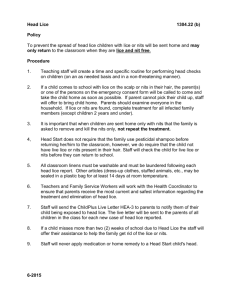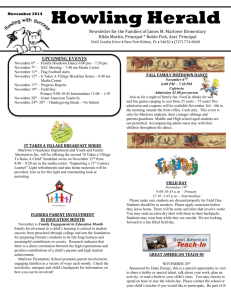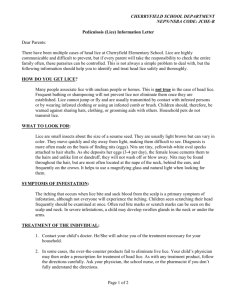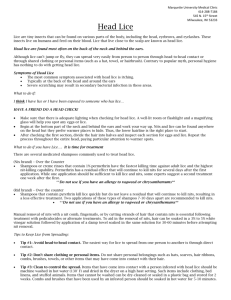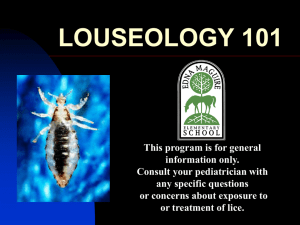HEAD LICE Fact Sheet
advertisement
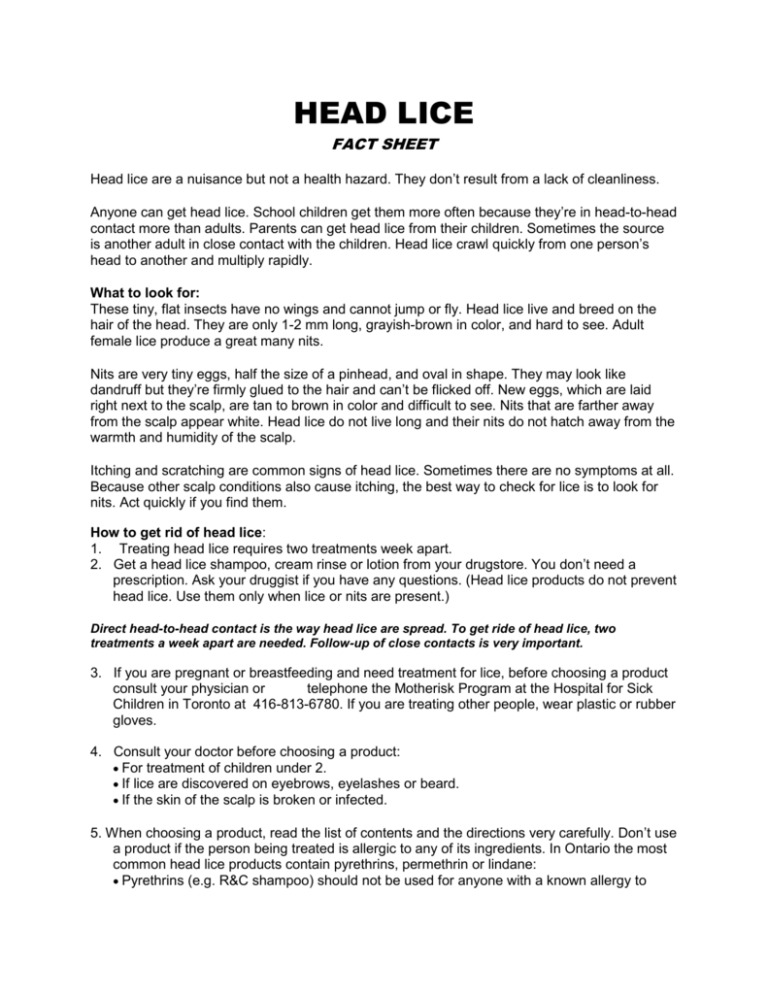
HEAD LICE FACT SHEET Head lice are a nuisance but not a health hazard. They don’t result from a lack of cleanliness. Anyone can get head lice. School children get them more often because they’re in head-to-head contact more than adults. Parents can get head lice from their children. Sometimes the source is another adult in close contact with the children. Head lice crawl quickly from one person’s head to another and multiply rapidly. What to look for: These tiny, flat insects have no wings and cannot jump or fly. Head lice live and breed on the hair of the head. They are only 1-2 mm long, grayish-brown in color, and hard to see. Adult female lice produce a great many nits. Nits are very tiny eggs, half the size of a pinhead, and oval in shape. They may look like dandruff but they’re firmly glued to the hair and can’t be flicked off. New eggs, which are laid right next to the scalp, are tan to brown in color and difficult to see. Nits that are farther away from the scalp appear white. Head lice do not live long and their nits do not hatch away from the warmth and humidity of the scalp. Itching and scratching are common signs of head lice. Sometimes there are no symptoms at all. Because other scalp conditions also cause itching, the best way to check for lice is to look for nits. Act quickly if you find them. How to get rid of head lice: 1. Treating head lice requires two treatments week apart. 2. Get a head lice shampoo, cream rinse or lotion from your drugstore. You don’t need a prescription. Ask your druggist if you have any questions. (Head lice products do not prevent head lice. Use them only when lice or nits are present.) Direct head-to-head contact is the way head lice are spread. To get ride of head lice, two treatments a week apart are needed. Follow-up of close contacts is very important. 3. If you are pregnant or breastfeeding and need treatment for lice, before choosing a product consult your physician or telephone the Motherisk Program at the Hospital for Sick Children in Toronto at 416-813-6780. If you are treating other people, wear plastic or rubber gloves. 4. Consult your doctor before choosing a product: For treatment of children under 2. If lice are discovered on eyebrows, eyelashes or beard. If the skin of the scalp is broken or infected. 5. When choosing a product, read the list of contents and the directions very carefully. Don’t use a product if the person being treated is allergic to any of its ingredients. In Ontario the most common head lice products contain pyrethrins, permethrin or lindane: Pyrethrins (e.g. R&C shampoo) should not be used for anyone with a known allergy to ragweed or chrysanthemums. Permethrin (e.g. NIX) should not be used for persons with a known allergy to chrysanthemums, synthetic pyrethroids, or pyrethrins. Do not use on children under age 2 unless directed by a physician. The hair should be washed with a conditioner-free shampoo and a conditioner should not be used after washing. Itching may increase for a while after treatment but this is not a concern. Lindane (e.g. Kwellada) should not be used for children under 2 years of age unless directed by a physician. For children ages 2 to 5, Lindane is recommended only on the advice of a nurse, pharmacist or physician. Sometimes head lice resist one product. If this happens, try another followed by the second treatment a week later. 6. When using a head lice product: Timing is important. If the product is rinsed off too soon, lice and nits may not be killed. If left on too long, you’re causing unneeded exposure to the lice-killing chemicals. Rinsing a child’s hair under a tap (instead of a shower) will limit skin exposure and prevent the child from swallowing some of the product. These products should not be used near the eyes, nose or mouth. A towel held tightly over the eyes protects them during treatment. When treating another person, wear plastic or rubber gloves to avoid unnecessary exposure to the product. Wash your hands well immediately after using a head lice product. Store unused head lice products away from the reach of young children. 7. Second Treatment: Apply a second treatment in one week to kill any newly-hatched lice before they can lay eggs (Repeat the treatment once only.) After the second treatment and removal of the nits, check the head twice a week for four weeks to make sure all lice and nits are gone. To remove nits: Head lice products kill many of the nits (eggs) but one treatment usually does not kill all nits. Removing the nits after treatment makes it easier to see any new infestations. Bright, natural light helps you see the nits better. Comb the hair to remove snarls, then take hold of a lock of hair. Use your thumbnail against your first finger to strip the nits from the hair starting from the roots right down to the tips. Place the nits in a bag. Pin back that lock of hair and continue until all nits are removed. Try to remove the very tiny eggs laid right next to the scalp. You can also comb-out the nits holding a fine-tooth comb on a downward angle. This is easier if a conditioner is used after treatment (but avoid after use of NIX). Some plastic or metal fine-tooth combs work better than others. Close contacts Follow-up of close contacts is very important. Check the heads of all family members. Also tell others such as grandparents or babysitters. All affected persons should be treated at the same time. Tell the school, daycare centre, and sports or other children’s groups so the parents can be told to check their children’s heads. Also tell the parents of all playmates to prevent the spread and protect your child from being reinfested. Cleaning personal items. Extra house cleaning and use of insecticide sprays are not needed. However, you will probably want to wash combs and brushes, headgear, pillow cases and towels in hot water. The heat of the water or the hot cycle of your clothes dryer will kill any live lice and nits. Points to remember: An untreated source among close contacts is a common reason for reoccurrence. Head lice do not live on dogs, cats or other animals, only on humans. Discourage children from sharing hats, scarves, combs, hair accessories and helmets. Keeping hair short will not prevent head lice. Check young school-age children regularly for head lice; more often if there is an outbreak.


